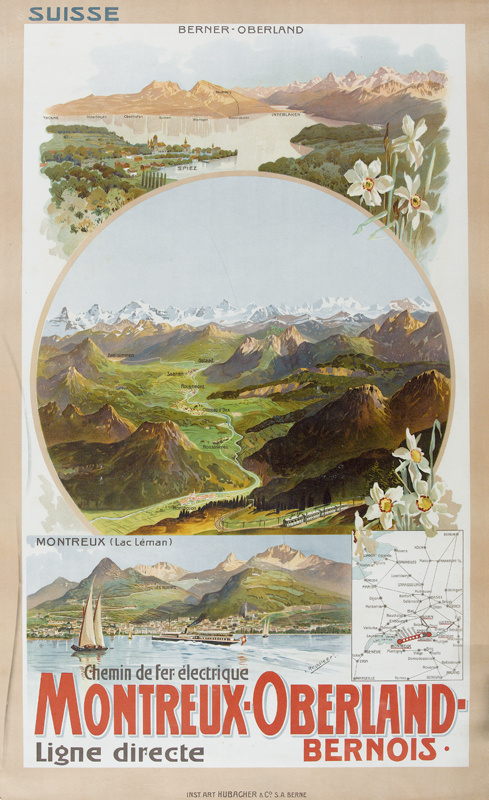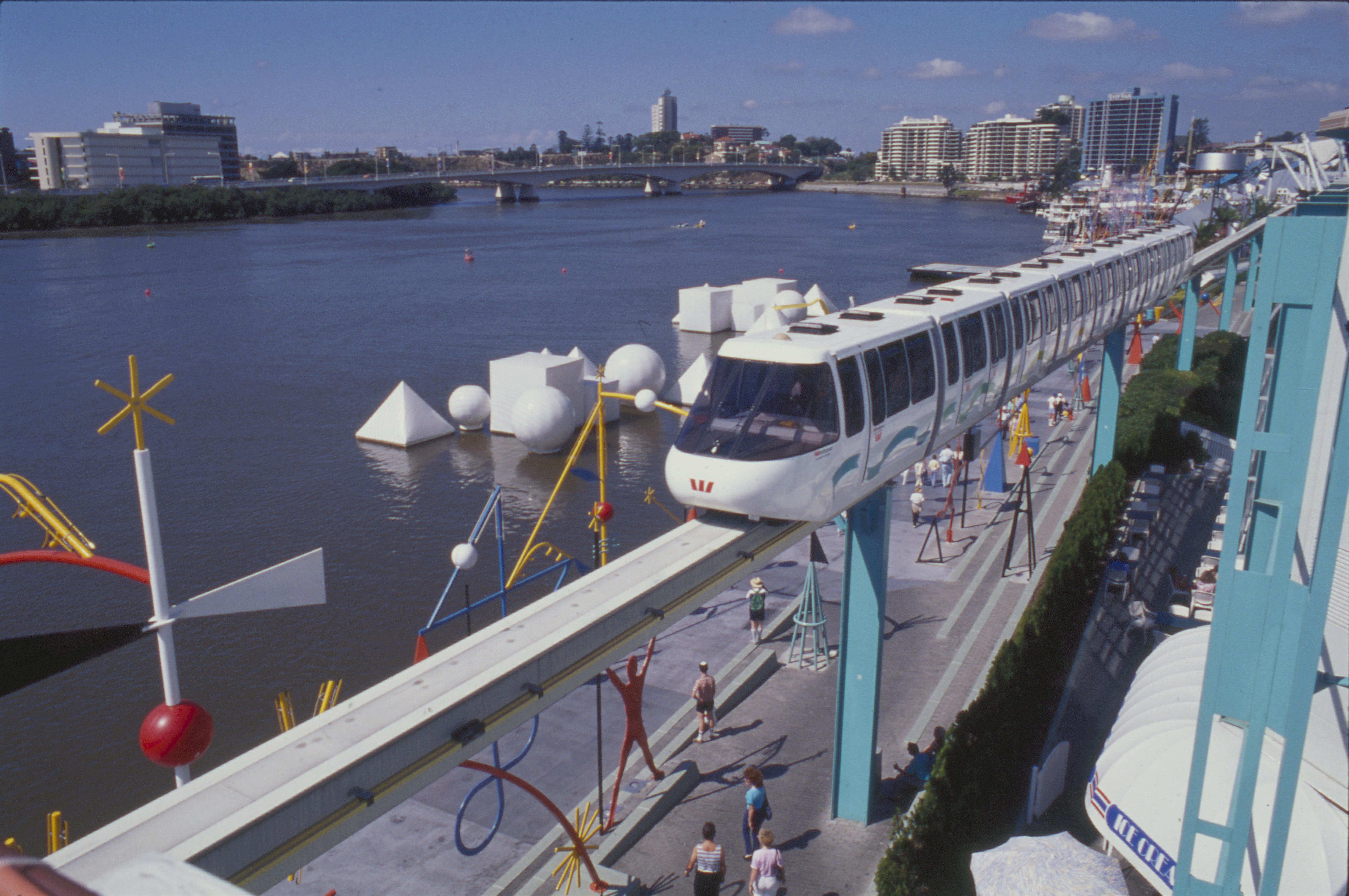|
Vevey–Chardonne–Mont Pèlerin Funicular Railway
The Vevey–Chardonne–Mont Pèlerin funicular railway (french: Chemin de fer funiculaire Vevey–Chardonne–Mont Pèlerin; VCP) is a funicular which runs between Vevey, a town on the north shore of Lake Geneva in the canton of Vaud, through the Chardonne vineyards of Lavaux to Mont Pèlerin. The line was constructed in 1899 and opened the following year. It is a single track of ) with a passing point but is unusual in that it has three intermediate halts (Corseaux, Chardonne and la Baume). The line rises from at Vevey to at its summit, a total of over its length, with a maximum gradient of 54% (1 in 1.84). Construction was by the Doppelmayr Von Roll consortium. Nowadays, the line, which is electrically operated, is automatic, with a journey time of 10 minutes. The operating company became part of the Transports Montreux-Vevey-Riviera (MVR) in 2001 and is now marketed by the MOB ( Montreux-Oberland Bernois) company under their GoldenPass services banner. Refurbishm ... [...More Info...] [...Related Items...] OR: [Wikipedia] [Google] [Baidu] |
Funicular
A funicular (, , ) is a type of cable railway system that connects points along a railway track laid on a steep slope. The system is characterized by two counterbalanced carriages (also called cars or trains) permanently attached to opposite ends of a haulage cable, which is looped over a pulley at the upper end of the track. The result of such a configuration is that the two carriages move synchronously: as one ascends, the other descends at an equal speed. This feature distinguishes funiculars from inclined elevators, which have a single car that is hauled uphill. The term ''funicular'' derives from the Latin word , the diminutive of , meaning 'rope'. Operation In a funicular, both cars are permanently connected to the opposite ends of the same cable, known as a ''haul rope''; this haul rope runs through a system of pulleys at the upper end of the line. If the railway track is not perfectly straight, the cable is guided along the track using sheaves – unpowered pulleys tha ... [...More Info...] [...Related Items...] OR: [Wikipedia] [Google] [Baidu] |
Lavaux
Lavaux () is a region in the canton of Vaud in Switzerland, in the district of Lavaux-Oron. Lavaux consists of 830 hectares of terraced vineyards that stretch for about 30 km along the south-facing northern shores of Lake Geneva. Although there is some evidence that vines were grown in the area in Roman times, the actual vine terraces can be traced back to the 11th century, when Benedictine and Cistercian monasteries controlled the area. It benefits from a temperate climate, but the southern aspect of the terraces with the reflection of the sun in the lake and the stone walls gives a mediterranean character to the region. The main wine grape variety grown here is the Chasselas. World Heritage site Under cantonal law, the vineyards of Lavaux are protected from development. Since July 2007, Lavaux is a UNESCO World Heritage Sites. Since 2016, the vineyards of Lavaux are not treated with synthetic pesticides any more. Hiking trail There are many hikes possible through ... [...More Info...] [...Related Items...] OR: [Wikipedia] [Google] [Baidu] |
Transport In Vevey
Transport (in British English), or transportation (in American English), is the intentional Motion, movement of humans, animals, and cargo, goods from one location to another. Mode of transport, Modes of transport include aviation, air, land transport, land (rail transport, rail and road transport, road), ship transport, water, cable transport, cable, pipeline transport, pipeline, and space transport, space. The field can be divided into infrastructure, vehicles, and business operations, operations. Transport enables human trade, which is essential for the development of civilizations. Transport infrastructure consists of both fixed installations, including roads, railways, airway (aviation), airways, waterways, canals, and pipeline transport, pipelines, and terminals such as airports, train station, railway stations, bus stations, warehouses, trucking terminals, refueling depots (including fueling docks and fuel stations), and seaports. Terminals may be used both for intercha ... [...More Info...] [...Related Items...] OR: [Wikipedia] [Google] [Baidu] |
Transport In The Canton Of Vaud
Transport (in British English), or transportation (in American English), is the intentional movement of humans, animals, and goods from one location to another. Modes of transport include air, land (rail and road), water, cable, pipeline, and space. The field can be divided into infrastructure, vehicles, and operations. Transport enables human trade, which is essential for the development of civilizations. Transport infrastructure consists of both fixed installations, including roads, railways, airways, waterways, canals, and pipelines, and terminals such as airports, railway stations, bus stations, warehouses, trucking terminals, refueling depots (including fueling docks and fuel stations), and seaports. Terminals may be used both for interchange of passengers and cargo and for maintenance. Means of transport are any of the different kinds of transport facilities used to carry people or cargo. They may include vehicles, riding animals, and pack animals. Vehicles may inc ... [...More Info...] [...Related Items...] OR: [Wikipedia] [Google] [Baidu] |
Defunct Railway Companies Of Switzerland
{{Disambiguation ...
Defunct (no longer in use or active) may refer to: * ''Defunct'' (video game), 2014 * Zombie process or defunct process, in Unix-like operating systems See also * * :Former entities * End-of-life product * Obsolescence Obsolescence is the state of being which occurs when an object, service, or practice is no longer maintained or required even though it may still be in good working order. It usually happens when something that is more efficient or less risky r ... [...More Info...] [...Related Items...] OR: [Wikipedia] [Google] [Baidu] |
Funicular Railways In Switzerland
A funicular (, , ) is a type of cable railway system that connects points along a railway track laid on a steep grade (slope), slope. The system is characterized by two counterbalanced carriages (also called cars or trains) permanently attached to opposite ends of a haulage cable, which is looped over a pulley at the upper end of the track. The result of such a configuration is that the two carriages move synchronously: as one ascends, the other descends at an equal speed. This feature distinguishes funiculars from inclined elevators, which have a single car that is hauled uphill. The term ''funicular'' derives from the Latin word , the diminutive of , meaning 'rope'. Operation In a funicular, both cars are permanently connected to the opposite ends of the same cable, known as a ''haul rope''; this haul rope runs through a system of pulleys at the upper end of the line. If the railway track is not perfectly straight, the cable is guided along the track using sheaves – unpower ... [...More Info...] [...Related Items...] OR: [Wikipedia] [Google] [Baidu] |
List Of Funiculars In Switzerland ...
This is a list of all funiculars in Switzerland, commercially operated according to a timetable. See also *List of funicular railways *List of heritage railways and funiculars in Switzerland *List of aerial tramways in Switzerland *List of mountain railways in Switzerland *List of mountains of Switzerland accessible by public transport References {{reflist, 30em ! Funicular railways in Switzerland A funicular (, , ) is a type of cable railway system that connects points along a railway track laid on a steep grade (slope), slope. The system is characterized by two counterbalanced carriages (also called cars or trains) permanently attached ... [...More Info...] [...Related Items...] OR: [Wikipedia] [Google] [Baidu] |
List Of Funicular Railways
This is a list of funicular railways, organised by place within country and continent. The funiculars range from short urban lines to significant multi-section mountain railways. A funicular railway is distinguished from the similar incline elevator in that it has two vehicles that counterbalance one another rather than independently operated cars. Africa South Africa * Cape of Good Hope, Flying Dutchman Funicular (opened 1996) Réunion * Saint-Benoît, Takamaka funicular (opened 1968) industrial funicular for Takamaka hydroelectric power stations employees Saint Helena * Jamestown, Jacob's Ladder (1829–1871) Americas Brazil * Niterói, Niterói funicular (1906- closed before 1950s) * Paranapiacaba, São Paulo Railway (two lines 1867–1982; now rack operated) * Rio de Janeiro: **Outeiro da Glória funicular (opened 1942; modernized 2003) **Paula Mattos funicular (1877-1926) * Salvador: ** (opened 1889) ** (opened 1981) ** (opened 1915) replacing a rack railway ... [...More Info...] [...Related Items...] OR: [Wikipedia] [Google] [Baidu] |
Trolleybuses In Montreux/Vevey
The Montreux/Vevey trolleybus system (french: Réseau trolleybus de Montreux/Vevey), also known as the Vevey–Villeneuve trolleybus line, forms part of the public transport network in Montreux and Vevey, in the canton of Vaud, Switzerland. It comprises a single long trolleybus route along the length of the (Vaud Riviera) on the north shore of Lake Geneva. Opened in 1957, the line is designated as line 201 (prior to 11 December 2010, line 1) of the local bus network, operated by '' Transports publics Vevey-Montreux-Chillon-Villeneuve'' (VMCV). In addition to line 201, the VMCV runs eight motorbus lines. However, with 5,204,000 passengers annually, the trolleybus route is by far the busiest of all the operator's lines, and generates 74 percent of its total revenue. The Vevey–Villeneuve trolleybus line is the last remaining of several interurban trolleybus lines that have existed in Switzerland. It largely follows Swiss main road no. 9, and passes through the municipalitie ... [...More Info...] [...Related Items...] OR: [Wikipedia] [Google] [Baidu] |
Montreux-Oberland Bernois
The Montreux Oberland Bernois Railway (french: link=no, Chemin de fer Montreux Oberland Bernois, german: link=no, Montreux Berner Oberland Bahn, abbreviated MOB), is an electrified railway line that operates in southwest Switzerland. It is one of the oldest electric railways in the country. Its main line, in length, is built to the gauge. It connects Montreux, Gstaad, and Zweisimmen. At Zweisimmen, passengers may transfer to the Zweisimmen to Spiez line — a standard gauge line owned by BLS AG. A branch-line also connects Zweisimmen to Lenk. History and route The main line of the MOB was opened in stages, the first, from Montreux to Les Avants () on 17 December 1901, followed by the Les Avants to Montbovon () section on 1 October 1903. The next stages from Montbovon to Château-d'Œx () and then Gstaad () followed on 19 August 1904 and 20 December 1904 respectively, the final of the line reaching Zweisimmen on 6 July 1905. The spur line to Lenk was opened in 1912. Fro ... [...More Info...] [...Related Items...] OR: [Wikipedia] [Google] [Baidu] |
Transports Montreux-Vevey-Riviera (MVR)
{{disambiguation ...
Transports may refer to: * Military transport aircraft * a Ministry of Transport * Dow Jones Transportation Average * '' The Transports'', a folk ballad opera written by Peter Bellamy See also * * Transport (other) Transport is the movement of people or goods from place to place. Transport may also refer to: Related terms * Especially in military contexts, a vehicle used to carry supplies or personnel, e.g. transport aircraft (other) or troopshi ... [...More Info...] [...Related Items...] OR: [Wikipedia] [Google] [Baidu] |
Von Roll
Von Roll Holding AG is a Swiss industrial group that operates worldwide. It was founded in 1803. As one of Switzerland’s longest-established industrial companies, Von Roll focuses today on products and systems for electrical applications such as power generation, transmission, and storage as well as e-mobility and industrial applications. History Von Roll has its roots in the ''Eisenwerke der Handelsgesellschaft der Gebrüder Dürholz & Co.'' (Ironworks of the commercial firm of the Brothers Durholz & Co.) which was established in 1803. This firm was then taken over in 1810 by Von Roll & Cie, newly formed by Ludwig Freiherr von Roll (1771–1839) and Jakob von Glutz. In May 1823, Ludwig von Roll founded the ''Gesellschaft der Ludwig von Roll'schen Eisenwerke'' which benefited from industrialization and railroad construction that demanded a lot of iron.Von Roll Holding AG This History of Von Roll/ref> Von Roll participated in the construction of the Wetterhorn Elevator in 19 ... [...More Info...] [...Related Items...] OR: [Wikipedia] [Google] [Baidu] |


.jpg)




